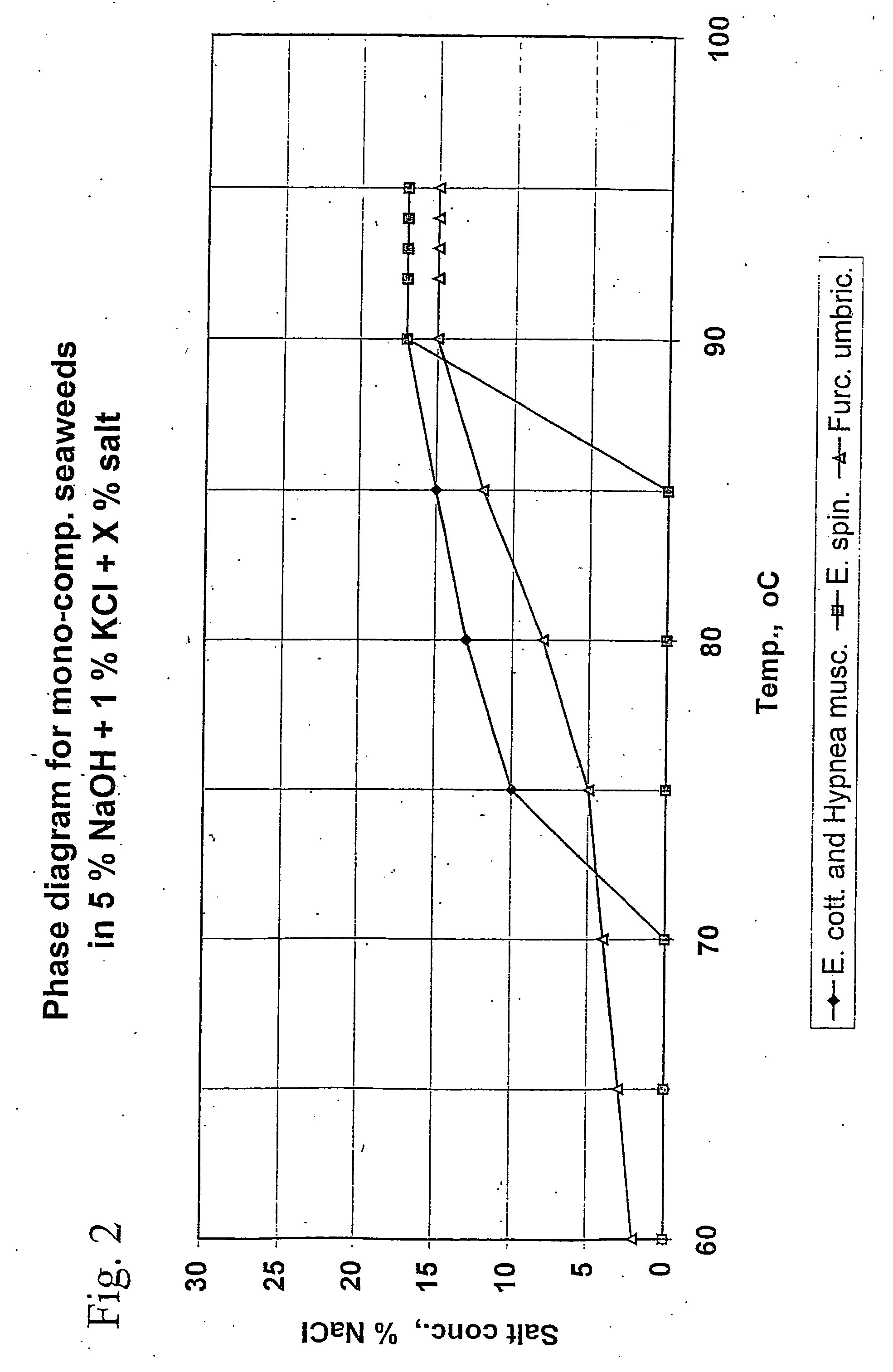Heterogeneous carrageenan manufacturing process from mono component seaweed with reduced use of level of koh
a carrageenan and mono-component technology, applied in the direction of sugar derivatives, sugar derivates, esterified saccharide compounds, etc., can solve the problems of high production cost, koh is an expensive chemical compared to other alkalis, and it is possible to cost-optimize the concentration of both ohsup>/sup> and ksup>, so as to achieve the effect of reducing alkali costs
- Summary
- Abstract
- Description
- Claims
- Application Information
AI Technical Summary
Benefits of technology
Problems solved by technology
Method used
Image
Examples
example 1
This example illustrates how the Viscosity Diagram of FIG. 1 and the Phase Diagram of FIG. 2 were constructed.
Approximately 10 kg of E. cottonii seaweed (approx. 60% solids) was chopped into pieces of sizes of 2-4 cm. These pieces were mixed thoroughly.
20 l of a alkali stock solution containing 5% (w / v) NaOH and 1% (w / v) KCl was then prepared. This alkali stock solution was kept at room temperature. A series of solutions of NaCl was prepared on the basis of the above alkali stock solution. These NaCl solutions had a NaCl concentration of 0, 5, 10, 15, 20 and 25% (w / v) respectively. These solutions were also kept at room temperature.
For each of the above six alkali solutions 1.8 l thereof was filled into a 3 l beaker mounted on a heating plate provided with a laboratory agitator (crossbarpropeller; : 50 mm) running at 240 rpm. Each solution was heated to 60° C. and 140 g chopped seaweed was added so as to obtain complete soaking of the seaweed. To each-beaker was added NaOH / KC...
example 2
This example illustrates the seaweed swelling factor and product qualities as a function of salt concentration in the alkali solution used for modification.
Preparation of SRC
Approximately 10 kg of E. cottonii seaweed (approximately 70% solids) was chopped into pieces having sizes of 2-4 cm and these were then mixed thoroughly. A stock solution of 120 l of 5% (w / v) NaOH and 1% (w / v) KCl was prepared and kept at room temperature.
A series of NaOH / NaCl / KCl solutions having concentrations of 0, 4.2, 8.4, 12.6, 16.8 and 21% (w / v) NaCl respectively was prepared by adding NaCl to the above stock solution. These were kept at room temperature.
For each of these six NaOH / NaCl / KCl solutions the following procedure was followed: 19 l of the solution was transferred to a jacketed thermostatic reaction vessel provided with slow agitation means and a bottom outlet. After heating to 60° C. 1 kg of the chopped seaweed was added and completely soaked in the solution. To the vessel was added ad...
example 3
This example illustrates that it is possible to obtain an incomplete alkali modification by conducting the alkali modification step in a solution having a reduced concentration of alkali.
Preparation of SRC
Approximately 10 kg of E. cottonii seaweed (approximately 60% solids) was chopped into pieces having sizes of 2-4 cm and these were then mixed thoroughly. A stock solution of 70 l of 24% (w / v) NaCl and 1% (w / v) KCl was prepared and kept at room temperature.
A series of three solutions having NaOH concentrations of 0, 0.8 and 5.0% (w / v) NaOH respectively was prepared by adding NaOH to the above stock solution. These three solutions were kept at room temperature.
For each of these three NaOH / NaCl / KCl solutions the following procedure was followed:
19 l of the solution was transferred to a jacketed thermostatic reaction vessel provided with slow agitation means and a bottom outlet. After heating to 75° C. 1 kg of the chopped seaweed was added and completely soaked in the solut...
PUM
| Property | Measurement | Unit |
|---|---|---|
| Fraction | aaaaa | aaaaa |
| Fraction | aaaaa | aaaaa |
| Fraction | aaaaa | aaaaa |
Abstract
Description
Claims
Application Information
 Login to View More
Login to View More - R&D
- Intellectual Property
- Life Sciences
- Materials
- Tech Scout
- Unparalleled Data Quality
- Higher Quality Content
- 60% Fewer Hallucinations
Browse by: Latest US Patents, China's latest patents, Technical Efficacy Thesaurus, Application Domain, Technology Topic, Popular Technical Reports.
© 2025 PatSnap. All rights reserved.Legal|Privacy policy|Modern Slavery Act Transparency Statement|Sitemap|About US| Contact US: help@patsnap.com



